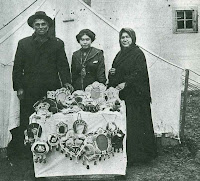 There was a time before plastic?
There was a time before plastic? What did kids in Wood County (and elsewhere) do before video games and plastic playthings? Following the days of handmade wooden and cast iron toys, toys made of tin filtered into children's land of make-believe. Tin toys first appeared around 1850, as mechanical mass-production became more common in the U.S.. The earliest toys were hand-painted using stencils, but were later decorated using color lithograph printing, which decreased production time and but also the detail. After 1900, tin toy design became increasingly complex with clockwork, wind-up, and steam powered motions.Vehicles, animals, and people were among the most popular types of tin toys. Germany, France, and later Japan and China cranked out record numbers of tin toys that rivaled or surpassed the quality and style of American-made toys. Many tin toys designs were modeled after current trends in transportation or entertainment. Miniature hot-air balloons, roller-coasters, milkmen, military craft and space rockets became some of the hottest selling choices during each image's era of popularity. These nostalgic playthings were eventually replaced by plastic and die-cast toys as toy producers began addressing durability, as well as the safety of metal edges and paint chemicals used in the earlier tin toys.
How are they made?
Tin products were actually made of steel or aluminum,although many do contain a thin coating of tin to inhibit rust. Production was mechanical and created multiple numbers of the same toy simultaneously. Two pre-painted, identical halves of a tin toy design were cut from a flat sheet of metal, then pressed into a 3-dimensional shape. The two halves were fitted together with interlocking tabs along the center seam.
 Birds-and-Bikes-and-Trains- Oh my!
Birds-and-Bikes-and-Trains- Oh my!
These four toys in the Wood County Historical Center's collection were all produced in the U.S. The duck, penguin, and tricycle were donated in 1982 by one Bowling Green, OH resident and originally date back to 1910-1915. With a few turns of his mechanical key, the little guy on the trike meanders left, right, and in circles while his bike bell dings. The duckling moved on its own once too, but its wind-up key and back wheel are missing, making it immobile. The dressed-up penguin also has a wind-up key that turns to send the penguin waddling.The train engine is part of a remote control, 1934 electric train set made by Marx & Co., with cloth-covered wires, metal tracks, and a total of six shiny red train-cars. The instruction sheet warns its child-age owners to "never forget to oil all gears and wheels before using, to keep the oil off the tracks, and to never leave the transformer ON if it starts smoking." ...And parents today might think an Easy Bake Oven is a "risky" toy! These tin toys are currently in storage at the Wood County Historical Center. Each toy is wrapped in acid-free tissue and is organized with other old-time toys in the collections attic.
 Birds-and-Bikes-and-Trains- Oh my!
Birds-and-Bikes-and-Trains- Oh my!These four toys in the Wood County Historical Center's collection were all produced in the U.S. The duck, penguin, and tricycle were donated in 1982 by one Bowling Green, OH resident and originally date back to 1910-1915. With a few turns of his mechanical key, the little guy on the trike meanders left, right, and in circles while his bike bell dings. The duckling moved on its own once too, but its wind-up key and back wheel are missing, making it immobile. The dressed-up penguin also has a wind-up key that turns to send the penguin waddling.The train engine is part of a remote control, 1934 electric train set made by Marx & Co., with cloth-covered wires, metal tracks, and a total of six shiny red train-cars. The instruction sheet warns its child-age owners to "never forget to oil all gears and wheels before using, to keep the oil off the tracks, and to never leave the transformer ON if it starts smoking." ...And parents today might think an Easy Bake Oven is a "risky" toy! These tin toys are currently in storage at the Wood County Historical Center. Each toy is wrapped in acid-free tissue and is organized with other old-time toys in the collections attic.

The World of Tin Toy Collecting
Today, tin toys are very popular collectors items and "Tin toys are now so rare that condition is sometimes not as important as it is for other more readily available toys," explains auctioneer, Rich Bertoia (2007). The bike, duck and penguin were produced by J. Chein & Co., a prominent toy company started in 1903 (which also manufactured tiny tin toys for Cracker Jack boxes!). There are a number of books and websites listing prices and and collectibility of each Chein toy. Dime-store size novelties can go from $25-80; larger, mechanical toys can be sold for as much as tens of thousands of dollars! You never know: Wood County's yard sales may just have some tin treasures worth more than a nickel....
Resources used for this post include:
Resources used for this post include:
Buhler, Michael. Tin Toys. Bergstrom & Boyle Books Limited: London. 1978.
Jaffe, Allen. The Chein Company: Toys, Tins, & Wastebaskets. Inside Collector. June, 1995.
Jaffe, Allen. The Chein Company: Toys, Tins, & Wastebaskets. Inside Collector. June, 1995.
Jailer-Chamberlain, Mildred. The Joy of Tin Toys. Antiques and Collecting Magazine. June 2007. p34-39.






